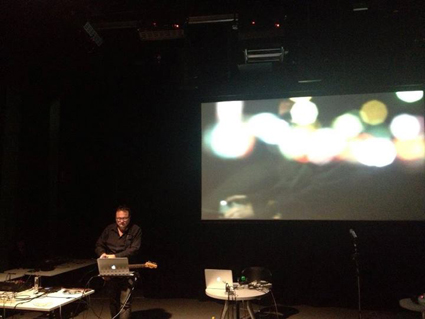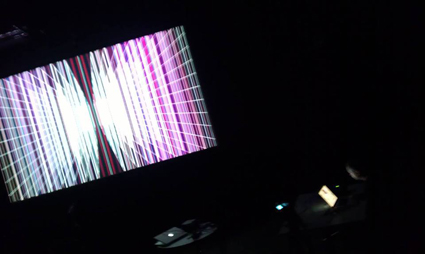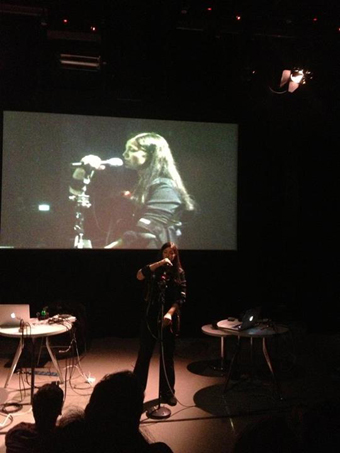July 24 2013
Past-present tensions
Keith Gallasch, Naala-Ba (Look Future), Carriageworks and ISEA2013
July 3 2013
Data noise & the limits of dance
Keith Gallasch, Myriam Gourfink & Kaspar Toeplitz, Breathing Monster
June 26 2013
Nailing the virtual
Virginia Baxter, Keith Gallasch, The Portals
Night work
Keith Gallasch, Embodied Media, Night Rage
Palpable virtualities
Keith Gallasch, Paula Dawson, Holoshop: Drawing and Perceiving in Depth
The big connect
Somaya Langley, The Portals
Transformational walking
Anne Phillips, Long Time, No See?
June 18 2013
Musical multiverses
Gail Priest, Polysonics
Rainbow over ISEA
Keith Gallasch, Electric Nights
realtime tv @ ISEA2013: Zydnei, Troy Innocent
June 17 2013
If a system fails in a forest, is anybody listening?
Urszula Dawkins, If a system fails in a forest…, 107 Projects
June 16 2013
In the digital age, love your stationery obsession
Urszula Dawkins, Durational Book
Painting by algorithms
Keith Gallasch, Ernest Edmonds: Light Logic
June 15 2013
Home, sweet home
Urszula Dawkins, disSentience, Sleeth, SelgasCano, Tin Sheds
Pop up pleasure zones
Gail Priest, Electronic Art Pop-Ups, The Rocks
June 14 2013
Aural ecologies, mechanical and musical
Urszula Dawkins, EchoSonics, UTS Gallery
June 14 2013
Heck, baby, I shoulda seen it comin…
Urszula Dawkins, The Very Near Future, Alex Davies
More than meets the eye
Virginia Baxter, Keith Gallasch, Point of View
New tools and old skool grammars
Gail Priest, Macrophonics II
realtime tv @ ISEA2013: The very near future, Alex Davies
Start by leaping off a small stool
Urszula Dawkins, ISEA Closing Keynote Address: Julian Assange
June 13 2013
A curative dose of spontaneity
Lauren Carroll Harris, pvi collective, Deviator
M e d i a a r t t h e n a n d n o w
Darren Tofts, Catching Light, Campbelltown Arts Centre
Olfaction, decay & speculation
Gail Priest, Raewyn Turner & Brian Harris, Ian Haig, Nandita Kumar, Verge Gallery
ART, WELLNESS & DEATH
Riding the theta waves
Urszula Dawkins, Theta Lab, George Poonkhin Khut and James Brown
Run for your lives [2]
Keith Gallasch, Running the City, COFA, UNSW
To re-map and reclaim
Lisa Gye, Mapping Culture [panel]
Turning the media back on itself
Lisa Gye, Mark Hosler, Adventures in Illegal Art
June 12 2013
Outside the labyrinth…looking in at someone waving
Urszula Dawkins, SoundLabyrinth, Mark Pedersen and Roger Alsop
realtime tv @ ISEA2013: semipermeable (+), SymbioticA
Run for your lives [1]
Keith Gallasch, Marnix de Nijs, Run Motherfucker Run
June 12 2013
The uncanny in the gallery
Keith Gallasch, Mari Velonaki, Simon Ingram, Petra Gemeinboeck & Rob Saunders, Artspace
June 11 2013
realtime tv @ ISEA2013: EchoSonics, UTS Gallery
The science and art of tangible things
Urszula Dawkins, Synapse: A Selection, Powerhouse
Touch me there
Gail Priest, ISEA Artist talks: Siu, Baumann, Velonaki
June 10 2013
Being Stelarc
Gail Priest, Stelarc: Meat, Metal, Code: Engineering affect and aliveness
Life and death, and the membranes inbetween
Urszula Dawkins, semipermeable (+), SymbioticA
realtime tv @ ISEA2013: Catching Light, Campbelltown Arts Centre
June 9 2013
'Pure' experience, in the round
Urszula Dawkins, Pure Land, iCinema
Data lives
Gail Priest, Genevieve Bell, Mark Hosler, Paolo Cirio & Alessandro Ludovico
realtime tv @ ISEA2013: Velonaki, Ingram, Gemeinboeck & Saunders, Artspace
June 8 2013
Knowing your place in Cartesian space
Gail Priest, Ryoji Ikeda, datamatics [ver 2.0]
Stars and starlings, pixels and picknickers
Urszula Dawkins, Ryoji Ikeda, datamatics [ver 2.0] & test pattern
 |
Julian Knowles, Macrophonics II
photo Cat Hope |
A common theme over the last seven days of ISEA2013 has been the relationship between old and new technologies. In his artist talk (part of the panel titled Nostalgia of the New, 9 June), musician/video artist Tom Ellard was emphatic that these terms old and new are essentially meaningless. He posed the provocation: does the pencil become old as soon as you stop using it? Does something become old as soon as it is out of your visual range?
Ellard draws parallels between the idea of ancestor worship—where in fact the relative is believed to still be present—and the idea of media ghosts, which I’m interpreting as ways of making that refuse to die. He proposed that what we see with the fetishisation of old technology is in fact the idea of “venerating the container” in the same way ancestor worshipers pray to urns and altars.
The Macrophonics II concert, featuring Julian Knowles, Donna Hewitt, Alon Ilsar and Wade Marynowsky positions itself right in the middle of this debate, exploring both old and new containers (technology) and media ghosts (aesthetics) with an emphasis on performativity. Knowles in his program notes states, “I’m particularly interested in finding the unique ‘voices’ of each media situation or technology and finding meaningful relationships between them in an effort to create ‘all media’ works as opposed to ‘new media’ works.”
Knowles opened the concert performing with guitar, laptop and a variety of tape machines—reel-to-reel, cassette and dictaphone. He starts delicately, with sustained guitar notes which he gradually surrounds with waves of hiss and crackle, building layers and adding beats until he approaches a post-rock epiphany. Knowles is captured live on grainy video by Wade Marynowsky, who filters and augments the image with coloured flares and flourishes.
Alon Ilsar follows, exploring his relatively new instrument, the AirSticks. Ilsar is a well-known drummer performing with artists and groups such as Meow Meow and Darth Vegas. His skills as an ‘analogue’ musician stand him in good stead with this digital instrument. There is great precision in his manipulation of the complicated spatial matrix devised for the hacked-game controller. The sounds become increasingly complex and multi-dimensional—a wrist twist creating dynamic tonal shifts, toe taps and hand flicks overlaying crunchy beats. Marynowsky accompanies the artist, fragmenting Ilsar’s image into small, multicoloured bars, walking a fine line between figuration and abstraction.
 |
Wade Marynowsky, Macrophonics II
photo Jon Drummond |
Watching these live video projections I had a brief moment of nostalgia for the VJ experiments of the early 2000s, but mostly I will admit to being more engaged by the gesturally rich performances in this quite intimate space. However Marynowsky’s solo audiovisual set was a highlight. In a festival that opened with Ryoji Ikeda, it was a bold move to present a piece in highly geometric, tightly synched glitch style; but Marynowsky made it his own, adding rich blues and pinks to soften the angularity, accompanied by crunchier textures and funkier beats.
 |
Donna Hewitt, Macrophonics II
photo Cat Hope |
The final performance by Donna Hewitt used both the eMic—an interactive microphone interface that she has been developing for over a decade—and her newer wearable interface (created with Knowles) which allows greater gestural play and interaction with sound. Hewitt comes from a pop/rock music background and her two pieces were unabashedly tonal with luscious harmonic layering reaching an almost symphonic scale. The control offered by the eMic is particularly impressive, allowing Hewitt to generate this complexly looped and layered composition without once returning to the laptop.
Macrophonics II was perhaps less about the tensions between old and new media and more about the interplay of aesthetics, technologies and micro and macro cultures. Knowles and Hewitt position themselves within a pop lineage rather than high-art computer music framework. Perhaps what Macrophonics II really illustrates is how the ‘new technologies’—these complex interfaces and processing systems—can break out of the niche of experimentalism and become part of the wider popular music culture with early examples like UK artist
Imogen Heap’s Glove project leading the way.
Macrophonics II, Julian Knowles, Donna Hewitt, Alon Ilsar, Wade Marynowsky, Bon Marche Studio, 13 June
© Gail Priest; for permission to reproduce apply to [email protected]
Back to top











 back
back